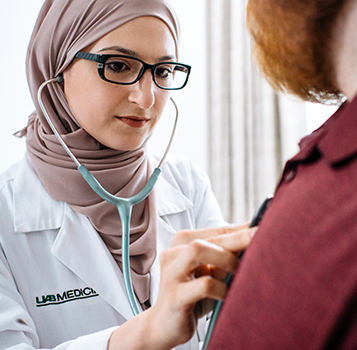Welcome to the Heersink School of Medicine’s newest series, Innovation in Action. This series will take you behind the scenes of some of UAB’s most innovative clinics, programs, and patient-centered services in the School of Medicine. Get started with us as we closely examine the UAB Medicine Cardiovascular Institute.
In this installment, learn more about the journey of the UAB Medicine Cardiovascular Institute (CVI), its rich history in treating cardiovascular disease, its vision for providing exceptional patient care, and some of its most notable achievements as it celebrates its fourth anniversary.
Among the five largest heart and vascular programs in the country, the CVI integrates the clinical service activities of cardiology, cardiothoracic surgery, vascular surgery, and cardiothoracic anesthesia under one structure to facilitate alignment of clinical care delivery across disciplines, the identification of care improvement opportunities, and shared strategic planning and decision making.
CREATING THE INSTITUTE
 UAB has a long and storied history in studying and treating cardiovascular disease dating back to the 1950s and 1960s when Tinsley Harrison, M.D.; John Kirklin, M.D.; and other renowned physicians began developing world-class cardiovascular programs within the departments of Medicine and Surgery.
UAB has a long and storied history in studying and treating cardiovascular disease dating back to the 1950s and 1960s when Tinsley Harrison, M.D.; John Kirklin, M.D.; and other renowned physicians began developing world-class cardiovascular programs within the departments of Medicine and Surgery.
Building upon this rich history, the CVI was formally established in June 2019 as one of three signature service lines within UAB Medicine with an overall goal to enhance patient care and improve the operational, financial, and competitive performance of cardiovascular services across UAB Medicine.
The five aims of the CVI are to:
1. Deliver value to cardiovascular patients
2. Develop and sustain the service line as the premier program in the Southeast region
3. Monitor, manage, and improve the operating margin of clinical programs
4. Promote the service line at regional, national, and international levels
5. Coordinate with and support the Research and Education missions
“Health system leadership recognized that we had an opportunity to take what was already a nationally ranked program and to invest further in our services to expand our ability to care for more patients within the state and region,” said James Davies, M.D., director of the Division of Cardiothoracic Surgery and co-director of the UAB Medicine Cardiovascular Institute. “Becoming a signature service line was the first step in this direction as we were able to better organize and support strategic planning efforts and identify key priorities with more stakeholder involvement.”
BUILDING THE FOUNDATION AND ADAPTING TO CHANGE
Upon its creation, CVI leadership engaged stakeholders in defining how they would organize and support service line activities through a new operating model.
“The signature service lines have a defined governance structure that involves not only service line leadership but also our department chairs, health system executives, and operational leaders in the hospital and ambulatory care environments,” said Lee Hammonds, MSHA, MBA, associate vice president of CVI. “We spent a considerable amount of time during the first year as a signature service line defining roles and responsibilities and aligning decision making. Some of that work continues to this day as we evaluate our systems and adapt as circumstances change.”
One such circumstance that no one could have predicted was the onset of the COVID-19 pandemic in March 2020. As luck would have it, the CVI undertook its first strategic planning retreat on March 3, 2020, just two weeks before COVID-19 shut down much of the standard operations, leading to significant changes in the work environment.
“We had our first big strategic planning event with more than 50 people in attendance in early March 2020. Working with our steering and executive committees, we had successfully established some baseline expectations for how we would work together and were really excited to finally be at a point of confirming priorities and focusing on value creations,” added Davies. “Within two to three weeks, everything shut down, and we spent the next several months like everyone else, focusing on maintaining our operations and caring for our patients.”
REFOCUSING ON PRIORITIES AND GETTING BACK TO THE WORK
 As the world began to normalize the realities of the pandemic and its aftermath, the CVI could refocus its work on strategic priorities.
As the world began to normalize the realities of the pandemic and its aftermath, the CVI could refocus its work on strategic priorities.
“Many of our goals and priorities that were identified back in March 2020 are still relevant. These focus on improving patient access and quality and growth in clinical services,” Hammonds remarked. “Interestingly, we had identified the adoption of new technologies to enhance patient access and engagement at our 2020 retreat and had listed telemedicine as an opportunity towards this end. The pandemic ended up serving as a catalyst for the achievement of this goal which otherwise would have taken much longer to implement.”
The CVI has also welcomed a new Cardiology division director and co-director of the institute, Nicole Lohr, M.D., Ph.D., FACC, who joined UAB in November 2022. “We were excited to welcome Dr. Lohr to UAB and felt her addition would add to our momentum within the CVI,” said Davies. “We’ve been able to refocus our efforts as a team, and she’s brought a fresh perspective coming to UAB from another organization.”
“I was really excited for the opportunity to come to UAB,” Lohr added. “Specifically, what attracted me to UAB, the Division of Cardiovascular Disease, and the CVI was the opportunity to be a part of a team that is really looking to be at the forefront of the treatment of cardiovascular disease. Like other organizations, we face some significant financial and operational challenges but also have a tremendous opportunity to innovate and to be the provider of choice for anyone with a heart-related condition in the state and region. No organization is better positioned than us to deliver on this potential.”
ON THE HORIZON
More recent efforts within the CVI have focused on supporting and enhancing new and existing clinical programs and evaluating opportunities to improve access and grow clinical services through community outreach and strategic partnerships. Additionally, increased emphasis has been placed on recruiting and retaining faculty and staff to support strategic growth and care delivery within cardiovascular services.
 “We recognize the need to continue to invest in our people,” said Lohr. “One of our goals is to engage our existing team members in our work through the CVI while also recruiting other high caliber clinicians to join us over the next few years as we grow and expand services.”
“We recognize the need to continue to invest in our people,” said Lohr. “One of our goals is to engage our existing team members in our work through the CVI while also recruiting other high caliber clinicians to join us over the next few years as we grow and expand services.”
Cardiovascular disease in Alabama and the region remains high and is predicted to increase due to the number of contributing risk factors prevalent in our communities. There is also a need for more cardiovascular specialists to care for patients in many rural areas of the state. As a result, the CVI is looking to grow its clinical coverage, building on existing partnerships within the state.
“On an almost daily basis, we are contacted about a potential need or opportunity to provide services outside our current footprint,” stated Davies. “We’ve been able to partner with hospitals in communities like Montgomery, Tuscaloosa, and Bessemer to provide CV services, and there are several others that need our support now or will in the future. We are working with leaders in the health system to develop strategies to meet the increasing need.”
These partnerships are in addition to also providing more services through UAB-owned and operated ambulatory sites in the greater Birmingham area and beyond. Currently, CVI specialists provide ambulatory care in communities like Gardendale, Hoover, and Alex City and have a longstanding cardiology practice at Acton Road.
“Our goal is to align with health system strategies for network development and growth and to pursue complementary strategies for growth through strategic affiliations and our own outreach activities,” added Lohr. “These efforts are all informed by our understanding of where our services are needed and how we can best care for the citizen of Alabama and beyond.”